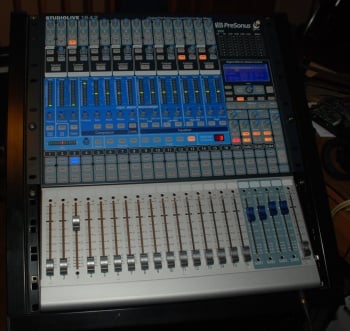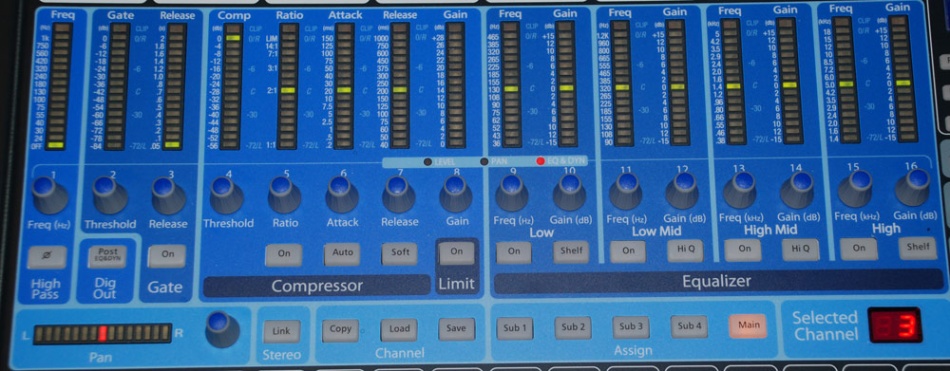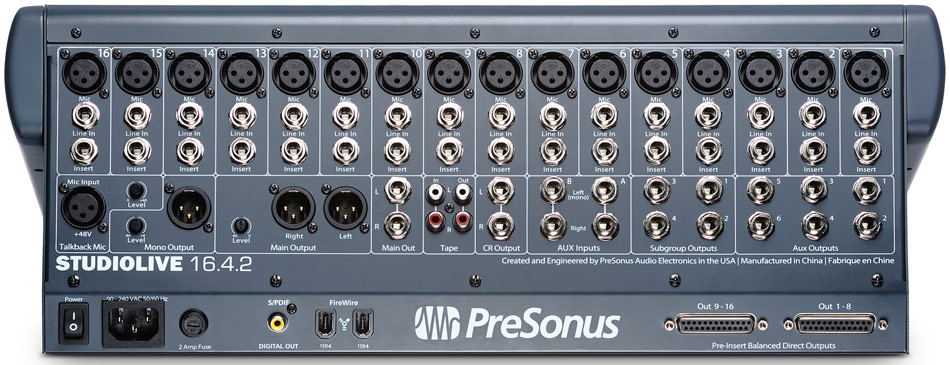Presonus Studiolive 16/4/2
Contents |
General Information
Original Author: Staffay
Weapon: Live/Studio Mixer with integrated soundcard
Make: Presonus
Model: Studiolive 16/4/2
Price: 2500€
Introduction
Presonus is an american company that manufactors mostly studio products in the semi-professional range, and are known for their Firestudio series of soundcards as well as good prizes vs. features on their products. StudioLive is an unique product since it's in-cooperate both a digital mixer and a 16-channel soundcard, making it extremely versatile in both handling and feature-wise. It has not really any competitors on the market, since You have to buy a separate mixer, audio-interface + soundcard for the digital mixers available. But a good guess is that the other manufactorers will follow this concept, since it's really is built for musicians on the move, and enables You to record Your live-concerts as well as doin pre-productions in You own home with the same equipment.
Technical Description
The heart of this machine is really the "Fat-channel", which is a combined gate, compressor, four band parametric EQ, High-pass filter and limiter. This features can be used on all channel & busses all over the mixer. It is connected to a computer via FireWire and all channels, busses etc. can be sent and received via a 32*18 interface. It has 16 mic/line XMAX preamps which has been borrowed from the FireStudio series, these have plenty of headroom and is quite as a mice. There is 6 AUX-channels available for using with effects/monitor -systems as well as a talkback system that works on all auxes + main. On the master-bus sits also an overall 31-band EQ to adjust to verall sound for Your PA-speakers/studio monitors. An outstanding feature is that You can store a mix-setup as a "scene", which means that with a push of a button, You can recall Your bands live-settings for every parameter on the entire console.
There is in addition to this two separate digital effects which can be routed anywhere in the signal-flow. It has S/PDIF outputs as well balanced pre-fader outputs for routing to other environments. Also there is insert points on every channel as well as direct outputs, that can be routed before or after the "fat-channnel". What it dont have though, is ADAT-compatible interface or any type of synchronization features. (which may be implemented later by firmware updates and some additional hardware) There is solo-in-place functions for studio-use as well as normal solo for stage use, which can be switchable by just pushing and holding a button. The mixer is a small piece of gear and sits easily on top of a standard rack unit. A point of interest is also that this piece of gear operates internaly on a 32-bit floating point frequency.
The soundcard part of this gear has also borrowed it's AD/DA -converters from the Firestudio series and have a very good conversion and dynamic range contrary the price, of course there are better converters available, but then You have to pay twice as much for just a pair of converters vs. what this gear costs. Comparing to converters in te same price-range I found them as good as the other manufactorers. The card supports sample rates of 44.1 and 48 kHZ, which may be annoying to some - where did the 96 kHx and 192 kHz go???? This is however not an issue, since these frequencies are mostly used for advanced masteríng and maybe in high-end studios with outboard gear that can operate on these frequencies.
In Use
Since I'm a quite experienced engineer myself and had worked a lot with different consoles, I must say that this one was not hard at all for me to handle, everything is quite logical and there is a good manual as well as a very informative support & forum pages at Presonus homepage. To get it up and running is a piece of cake, the only matter that was a little bit confusing at first were the metering and operating of the aux & effects channels. Since it's a FireWire device there's some precautions that must be made in order to make it work with a lap-top since that is actually what You wanna do in a live situation. (computer-wise) Bundled with the console is Capture, a simple application used for just capture live recordings. The files can thereafter be imported into any DAW for further processing with the StudioLive as the sound-engine.
One interesting point here is that You can actually use Your DAW-effects for live usage since the FireWire streams in both directions in real-time. Also You can use pre-recorded tracks to team up with the band in a live situation since recording and playback can be done simoultaneusly with the easy-to-go Capture software. One outstanding feature is that You in a live-situation can select whether to dump the sound to the computer before or after the fat-channel, since most people may just want to have the sound that is coming from the mics and the pre-amps with no EQ, effects and so on.
In a studio situation, You will probably go for a "hybrid" way of mixing. Since the parameters of the console itself is not automateable via MIDI, a good suggestion will be to automate levels, DAW-effects etc. from the DAW itself and then do some of the mixing the "good-ole-way" on the console and then record back the total mix to the DAW for mastering. Full automation and fader-automation can be found on other digital boards, but again - then we are talking bout' twice as much money. Presonus has announced that some parameters maybe will be automatable via a Firmware update in the future, and that this will work with their own new DAW Studio One.
So I found this gear easy to use, a drawback might be that the faders that feels a little bit "plastic". Once You get the system up and running it works just great! Another bonus from Presonus that comes with the desk, is a real recording made of a live band that You can play around with to discover what this desk is capable of. A guy at a forum I read, stated that he have paid the cost for the whole desk in three weeks by just doing live-recordings for his friends and the day after selling back CD's to the bands.....
Sound
This is a very clean sounding and transparent desk. It just takes the sound as it really is and adds no colour what I believe. I compared it sound-wise to my TC Konnekt 48 card, and cannot hear any bigger differences. Compared to an old analog desk as a Soundcraft or a Studiomaster and such, it may lack some warmth - but so does all hardware in the digital domain. This can be easily fixed both live and in studio with a two-channel tube-compressor or similar and is not really an issue, rather a matter of taste. The fat-channels sounds terrific and comes with a lot of presets for vocals, guitars, percussion, basses etc. making it a breeze to initially set up a channel strip. Even the headphone amps have enough gain, something that usually would be a matter on consoles. Soundwise it is very well comparable to both Yamaha's and Soundcrafts desks within the same semi-professional range.
Feel
Overall Impression
Alternative Weapon
(Feel free to add other headings as appropriate for your review)








